| |
 |
 |
 |
| Comment on this report, or find other reports. |
 |
| Our Mystery Worshippers are volunteers who warm church pews for us around the world. If you'd like to become a Mystery Worshipper, start here. |
 |
| Find out how to reproduce this report in your church magazine or website. |
|
|
| 2862: Eglise Saint-Thomas, Strasbourg, France |
 |
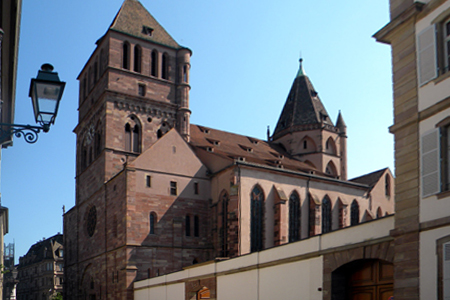 |
 |
Mystery Worshipper: Paterfamilias.
The church: Eglise Saint-Thomas, Strasbourg, France.
Denomination: Protestant Church of the Augsburg Confession of Alsace and Lorraine.
The building: It was constructed from 1196 to 1521, and thus has Romanesque (its exterior) and Gothic elements. Having been in the forefront of the Reformation (Martin Bucer, the leading Protestant reformer in Strasbourg, served there as pastor), the church has undergone a number of changes over the centuries, especially the interior. The altar is now in the center of the church, surrounded by seating on all four sides. The most distinctive features are its two organs (built in 1741 and 1905, respectively), and a number of tombs dating from the 12th to the 19th centuries. The most impressive mausoleum is that created by the sculptor Jean-Baptiste Pigalle for the French general Maurice de Saxe in 1777. Upon de Saxe's death, the Catholic Church reminded Louis XV that he could not receive the last rites, as he was of uncertain parentage, a German, and a Lutheran. And so it was decided to offer him a decent burial at the Lutheran Saint-Thomas. Pigalle spent over 20 years working on an appropriate monument for de Saxe.
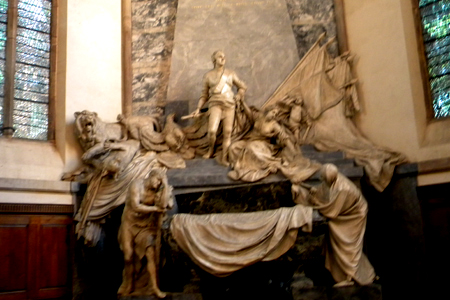
The church: Saint-Thomas is the largest Lutheran church in Alsace. It was heavily involved in the Lutheran Reformation from its inception; as early as 1524 the eucharist was celebrated in the vernacular, and with communion distributed in both kinds. In spite of the many times Strasbourg has moved from Germany to France, and back, and back again, Saint-Thomas has remained Lutheran. The parish supports elementary and secondary schools, and a seminary. In 1988, Pope John Paul II met Protestant leaders of Alsace at Saint-Thomas and joined them in a prayer service. Saint-Thomas holds a daily (Monday through Saturday) mid-day prayer service (bilingual, and on occasion trilingual – German, French, and English), and two Sunday morning services, one in French and one in German.
The neighbourhood: Strasbourg is a city of roughly a quarter of a million residents, on the border with Germany. It was originally German, became a part of France in 1648 after the Thirty Years War, then a part of Germany again after the Franco-Prussian war of 1870-71, and finally a part of France after the First World War. It is home to the European Parliament and the European Court of Human Rights. Saint-Thomas borders the River Ill, and is in Strasbourg's old town, amidst both upscale shops and more touristy stores, and a host of delightful restaurants.
The cast: There was a worship leader who led the service, and an organist. There was no service leaflet, and no information as to who they were. The worship leader wore a sports coat, white shirt, no tie.
The date & time: Friday, 22 May 2015, 12.10pm.
What was the name of the service?
Mid-day Prayer.
How full was the building?
Nearly empty. In addition to the worship leader and organist, there were nine, then seven (two left midway through) in the congregation.
Did anyone welcome you personally?
No.
Was your pew comfortable?
Not really; very straight, and very short back.
How would you describe the pre-service
atmosphere?
Quiet, reverent, but with several tourists walking about snapping photos.
What were the exact opening words of the
service?
I'm not sure, but they were in German, then repeated in French.
What books did the congregation use during the
service?
No service books or hymnal were in the pews, and there was no service leaflet.
What musical instruments were played?
The Silbermann organ (built by Andreas Silbermann, not his more famous uncle Gottfried Silbermann) dating from 1741 and played by both Mozart and Albert Schweitzer. The instrument underwent various changes, many to accommodate the changing musical tastes of the Romantic era, until in 1979 Alfred Kern of Strasbourg restored it to very nearly its original specifications (the echo manual was given several additional stops, and additional couplers were added). Against the back north wall is a display with the original console of the Silbermann, the text of the letter Mozart wrote to his father after playing in Strasbourg, and cardboard cutouts of Mozart and Schweitzer.
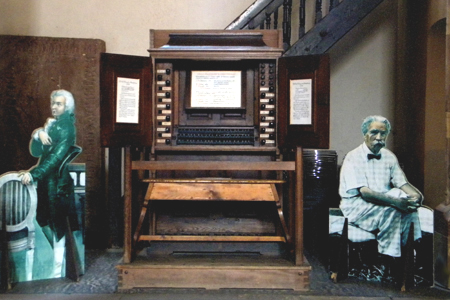
Did anything distract you?
Only the tourists who were present up until the very start of the service.
Was the worship stiff-upper-lip, happy clappy, or
what?
A simple liturgy of the Word, with interspersed organ pieces. After a brief introduction (German and French), we heard a prelude by Bach, then a reading (in German, then French), another organ piece, a second reading (in French, then German), a third organ piece, followed by a brief meditation (French only). After a period of silence, there were prayers (French only), a final organ piece, and a blessing (German, then French).
Exactly how long was the sermon?
4 minutes.
On a scale of 1-10, how good was the preacher?
9 – The worship leader spoke clearly, without histrionics, in a rich baritone voice.
In a nutshell, what was the sermon
about?
His text was John 19:26 ("Woman, behold thy son"). But my French is not good enough to know exactly what he had to say about this passage.
Which part of the service was like being in
heaven?
Hearing the Silbermann organ; the first piece was a Bach prelude, the final sounded an awful lot like the contemporary composer from Estonia, Arvo Part. The organ pieces were brief and didn't exactly show off the instrument, but just realizing that it is the same instrument Mozart played, and Schweitzer, was still thrilling.
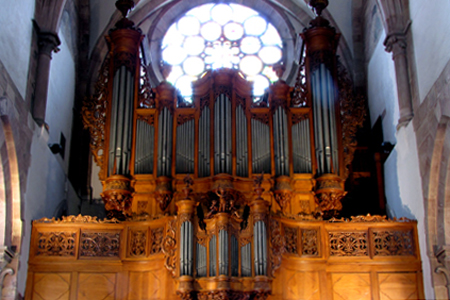
Photo:
© Ralph Hammann and used under license
And which part was like being in... er... the other place?
I would not want to sit through an extended Lutheran sermon in those pews! And a simple half-page order of service would help foreign tourists visiting Saint-Thomas have a better sense of what is going on. Perhaps for such small congregations they feel that preparing bulletins for six services a week would not be an effective use of staff time.
What happened when you hung around after the service looking lost?
Nothing; the congregation dispersed quickly and the tourists returned.
How would you describe the after-service
coffee?
There was none.
How would you feel about making this church your regular (where 10 = ecstatic, 0 = terminal)?
6 – Really not fair to judge after one 20-minute service. I am Lutheran, and have felt quite at home visiting Lutheran parishes in other parts of Europe. However, Lutherans in Alsace seem to be rather low church, so if we lived here I would probably join Materfamilias in a Catholic parish.
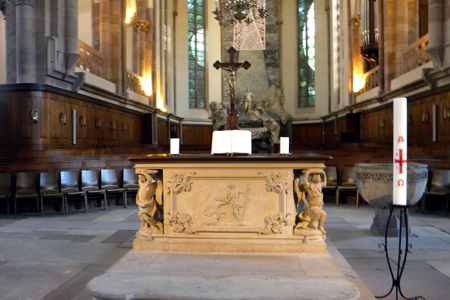
Did the service make you feel glad to be a
Christian?
Yes, it did. It was good to see such an historic parish offering the daily prayers of the Church.
What one thing will you remember about all this in seven days' time?
The quite elaborate mausoleum, and the story behind it. |
|
|
 |
 |
 |
| We rely on voluntary donations to stay online. If you're a regular visitor to Ship of Fools, please consider supporting us. |
 |
 |
 |
| The Mystery Pilgrim |
 |
| One of our most seasoned reporters makes the Camino pilgrimage to Santiago de Compostela in Spain. Read here. |
 |
 |
 |
| London churches |
 |
| Read reports from 70 London churches, visited by a small army of Mystery Worshippers on one single Sunday. Read here. |
| |
|
|
|
|


